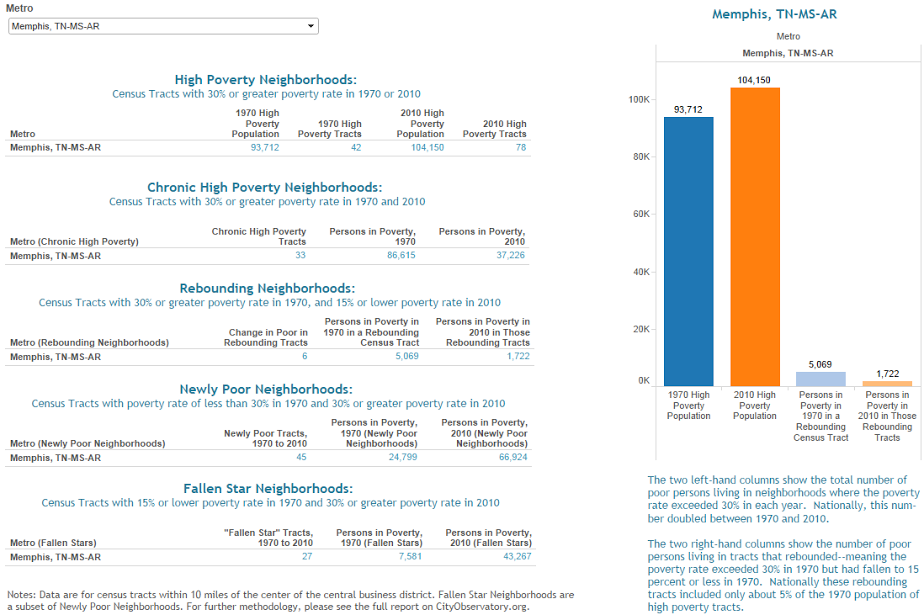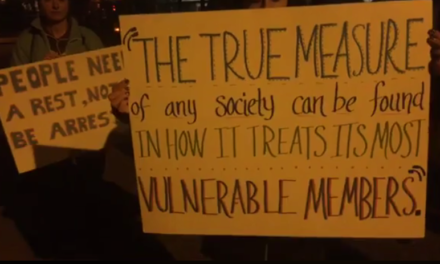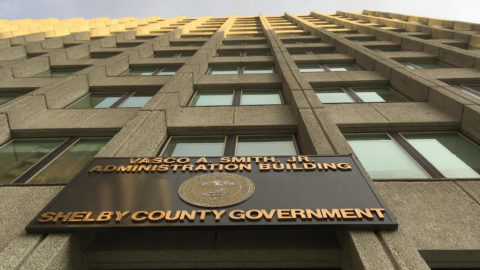Memphis should be so lucky as to have a gentrification problem.
If it did, it would indicate that people are moving back into Memphis core neighborhoods and that confidence in the city’s future is rising.
But while the “g word” gets more attention and attracts more angst, it’s the “p word” that deserves our focus and our concern – poverty, specifically, concentrated poverty.
For us, the gentrification map by Governing magazine underscored the absurdity of the level of alarm that’s brought to this issue. Its prime examples of gentrification in Memphis since 2000 include Uptown, a downtown area from Foote Homes to Shelby County Jail, EDGE/Medical Center, Soulsville, and Sherwood Forest. For 1990 to 2000, the prime example is Harbortown.
It’s The Poverty, Stupid
It’s reminiscent of the academic paper a few months ago that concluded that the biking culture here was a contributor to inequality and gentrification. That article felt more than anything like a conclusion looking for a justification, referring hyperbolically to Memphis’s “bicycling boom” although bikers amount to about .2% of population and to the “massive increase in bicycling infrastructure…(which) contribute to racialized gentrification.”
Like Governing, the authors fundamentally misunderstood the data within the context about South Main’s revival, and drew the assumption that if more people moved into South Main, they were displacing people with lower incomes.
In December, Joe Cortright’s City Observatory report looked at the 51 largest metro areas, including Memphis. He mailed: “We challenge frequently repeated narratives about the extent and impact of gentrification on urban poverty. Tracking change through shifts in poverty rates, the report shows that there have been remarkably few instances nationally of gentrification in which previously high poverty neighborhoods have seen their poverty drop to below the national average.
“Far more common has been the persistence and spread of concentrated poverty. Three-quarters of 1970 high poverty neighborhoods are still high poverty today. And the number of urban neighborhoods with poverty rates over 30 percent has tripled, and the number of poor living in these neighborhoods has doubled since 1970. This is alarming because a large and growing body of evidence confirms the devastating effects of living in and growing up in high poverty neighborhoods.”
Stability of Poverty Neighborhoods
In addition, the report spoke directly to the fallacies of the Governing article and the bicycle boom report with this comment: “It’s often argued and widely believed that the movement of higher income people into low income communities invariably produces one-for-one displacement of current poor residents. Our data show this gentrification narrative is misleading: precious few poor urban neighborhoods have rebounded, and those that have seen declines in poverty have recorded net increases in population. In contrast, high poverty neighborhoods that have seen declines in poverty have recorded net increases in population.”
As for Memphis, between 1970 and 2010, the number of high poverty neighborhoods climbed dramatically from 42 to 78 census tracts. Meanwhile, the population living in those census tracts increased from 93,712 to 104,140.
In other words, while the number of high poverty census tracts almost doubled – 87%, the population only increased 11%. It speaks to the historic level of migration out of Memphis neighborhoods, lured by the policies of county government that propelled sprawl and essentially required Memphians to pay for the decay of their own neighborhoods.
Massive Migration
Meanwhile, neighborhood infrastructure that was already paid for was abandoned as new roads and schools enticed more and more people from within the 1970 city limits of Memphis and county debt and maintenance costs climbed. In a presentation to Memphis City Council this week on plans to revive some inner city neighborhoods, architect Ray Brown pointed out that in the neighborhoods, 50% of the lots are now vacant and that doesn’t even include the houses that are vacant.
It speaks to the massive loss of property tax revenues in Memphis neighborhoods that took place as 169,827 people moved outside the 1970 city limits of Memphis between 1970 and 2013. In other words, the equivalent of the population of Chattanooga moved outside of the 1970 city limits of Memphis.
Here are the numbers: The population of 1970 Memphis was 619,757, but by 2013, the population within those 1970 city borders was 449,930, a decline of 27%.
Knowing that hindsight is 20-20, it’s hard not to see the absurdity of the lack of action that characterized an era when the city was deteriorating in such a fundamental way, mostly due to building new developments outside Memphis and disguising them as “growth.” What we needed was a very specific strategy of interventions in neighborhoods that could make them more appealing for new investment.
It can be done now if we pick the neighborhoods where there are still some strengths and/or assets to build on and start there. But then again, it’s hard to even tackle this without a real, functioning planning department like all of our peer cities.
Memphis’s Fallen Stars
But we digress. Back to gentrification.
“The result of these trends is that the poor in the nation’s metropolitan areas are increasingly segregated into neighborhoods of concentrated poverty,” the City Observatory report said. “These high-poverty neighborhoods were not stable – in the aggregate, they lost population, with chronic high-poverty neighborhoods losing 40% of their population over four decades.”
In fact, the report said, the growth in the number of poor people in “fallen star” neighborhoods dwarfs the decrease in the poverty population in the “rebounding” neighborhoods.
Fallen star neighborhoods are census tracts with 15% or lower poverty rates in 1970 and 30% or greater in 2010. Memphis had 27 fallen star census tracts. Their population in 1970 was 7,581, but by 2010, it was 43,267.
Rebounding neighborhoods are census tracts with poverty rates of 30% or more in 1970 and which had poverty rates of 15% or lower in 2010. There were six of these census tracts, but their population had fallen from 5,069 to 1,722.
Mythic Memphis
Other economists like Mr. Cortright are confirming his conclusion: that there is no evidence that poor people moved out of gentrifying neighborhoods at a higher than normal rate. More to the point, gentrification, as defined by the displacement of low income African American families by well-off Caucasians, is essentially a myth. In fact, the socio-economic profile of a neighborhood is remarkably stable over time.
As one commentator said: “The problem isn’t so much that gentrification hurts black neighborhoods. It’s that it too often bypasses them.”
Or as Frayser Community Development Corporation head Steve Lockwood wrote in a March 6, 2015, Smart City Memphis blog post: “Yes, our problem is not gentrification. Our problem is that many of our neighborhoods are too cheap, not the other way around.”
About the City Observatory report, Brookings Institution wrote: “Gentrification certainly comes with attendant dangers for low-income families, which policy makers should be on guard against. But it comes with potential benefits too, so we should be careful about simply ‘protecting’ neighborhoods from the process. Policies and regulations that insulate impoverished neighborhoods from gentrification could end up condemning these communities to yet another generation of deep poverty and segregation.”
**
Join us at the Smart City Memphis Facebook page for daily articles, reports, and commentaries relevant to Memphis.







Gentrification in a poor, crime-ridden, blighted, backward city like Memphis is very much a pipe dream.
We often boast about the “gentrification” and “revival” of midtown and downtown, but true gentrification and real progress even in those areas are myths.
Memphis is in deep trouble and has huge problems led by poverty and crime. Our new mayor is obviously overwhelmed at the real extent of the problems. Depressing and sad.
Poverty is our biggest single problem in Memphid today. Regarding gentrification, it just won’t take root in such an environment. I’d venture to say Memphis is at least 20 years behind similar sized cities in terms of gentrification.
I’d venture to say many of the comments posted by the above author shows he/she is about 20 years behind in their social and critical thinking development. It is depressing and sad the same troll keeps posting on these articles. Can you imagine so little of a life beyond the web? The owner of this blog has incredible patience to allow the same ignorant author to copy paste their comments no matter the topic.
I still like reading the main posts on this website; both informative and thought provoking.
I think it’s difficult to apply the national narrative of gentrification to Memphis, but it certainly exists in highly desirable urban centers.
A comment like this “there is no evidence that poor people moved out of gentrifying neighborhoods at a higher than normal rate” is absurd. Ask a resident of D.C. a city that a generation ago has a 70%+ black population but where blacks now make up a minority of the population.
Large numbers of black people could no longer afford to live in the District. So calling on neighborhoods to become ummmm “vibrant” (developer lingo) often entails moving out poor blacks so that highly educated Asians and Whites can move into those charming row houses.
In San Francisco the black population is less than half of a generation ago and now Oakland is losing segments of its black population as property values increase.
We are seeing a reverse white flight in many highly desirable cities. We don’t feel this in Memphis because highly educated Asians and Whites have no reason to move here en masse.
But to claim it does not exist in the marketplace of cities is not true.
As someone said to us once, why exactly are black folks not supposed to make a windfall from their property like white folks? It’s a gross oversimplication of course, but what the research indicates that while there are some cities – not many – where gentrification is taking place, there are many, many more where the real problem is concentrated poverty.
The problem with pretending that gentrification does not exist is that it shuts down the conversation on solutions. Which are often same solutions that can help defeat systemic poverty: universal pre-K, a higher minimum wage, expanding medicare, making community college free are just some of the solutions that the progressive left have proposed to alleviate the effects of poverty and gentrification.
The “think tanks” and opinion leaders who claim gentrification does not exist are often funded by developers and large corporations who have an interest in selling the “nothing to see here, move along” narrative. Those funders and the right of center politicians who cater to them are, of course, the same set that oppose many of the progressive solutions I outlined above.
Displacement of people of color and lower income people in general is happening in many urban cores. Gentrification and the effects of increased housing costs was front and center in the last Nashville mayor’s election.
To dismiss its very existence as black people making a fortune from selling their inter city homes to whites is a developers centric canard and it glosses over the fact that most people in urban city cores rent.
Peter: We don’t think it shuts down the conversation. It just puts the emphasis where it belongs – poverty, disparities, and inequities. As for Joe Cortright’s work, we vouch for its unbiased work, as exhibited by the fact that he attracts none of the money from the special interests like developers.
PS: If you have not read Joe’s reports on this issue, we highly recommend them.
The “academic paper a few months ago that concluded that the biking culture here was a contributor to inequality and gentrification” was one of the most absurd studies I have ever wasted my time in reading. It actually lowered my respect for the Department of Sociology at the University of Memphis by at least one whole degree. How could such badly flawed data and foregone conclusions pass as any form of academic research? If that paper is any indication, I doubt that we have the information necessary to measurably define gentrification in the first place let alone draw any conclusions.
Amen. It did indeed read like a conclusion in search of justification. It was published by the journal Urban Studies, which I believe is located in UK. Authors were Kevin T. Smiley from Rice University; Wanda Rushing of the University of Memphis; and Michele Scott of North Carolina State University.
Cortright’s work has the fingerprints of the Brookings Institute all over it. A bought and paid for “think tank” best known for taking corporate and foreign government funding to “study” issues.
“The funding sources of some Brookings-affiliated researchers call into question the independence of their research and its conclusions,” Sen. Warren wrote in her letter to Brookings. – Boston Globe , 2015
Actually, Peter, his work doesn’t always conform to the Brookings work and he has his own research group at City Observatory. Again, he’s recognized an independent, provocative voice on urban issues.
Some of the above comments framed “developers” in a negative light. (NB: I’m not a developer) What has often struck me when we enter into discussions of gentrification and housing affordability is the role that governments play in perpetuating the problem, rather than the developer who is responding to market demand. From my perspective, if we would entirely remove the shackles of zoning codes–density limitations in all forms and parking minimums which increase cost of development–we might finally allow developers to build to meet demand, and finally the achieve the goal of affordable housing. It seems odd that we would complain about the unavailability of affordable housing all the while demanding that we have an artificial scarcity of housing units. This of course does not necessarily pertain to Memphis where on Zillow I have found many reasonable houses for 20k or less.